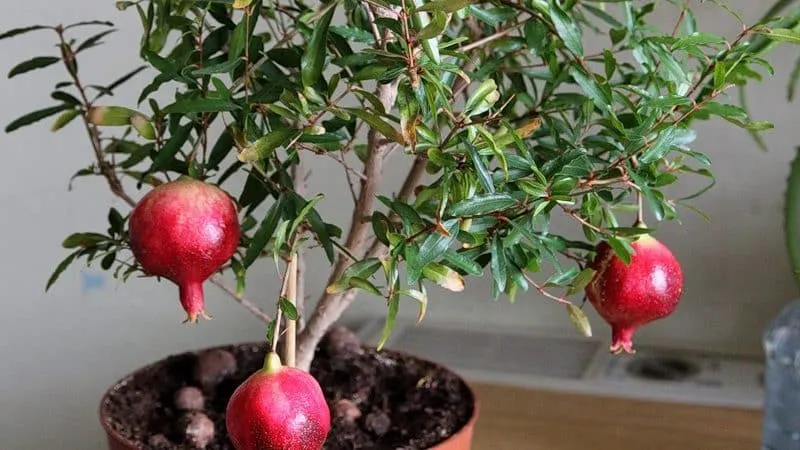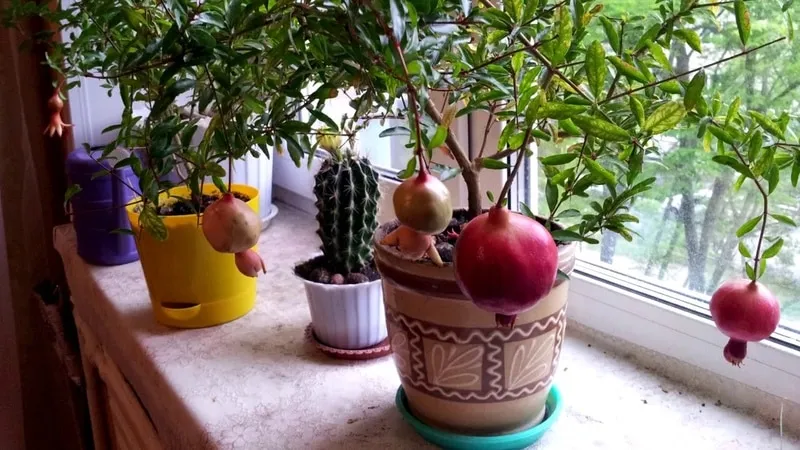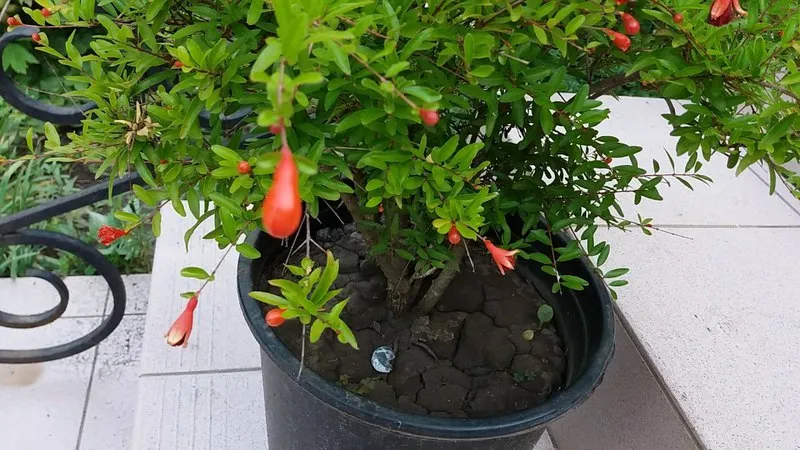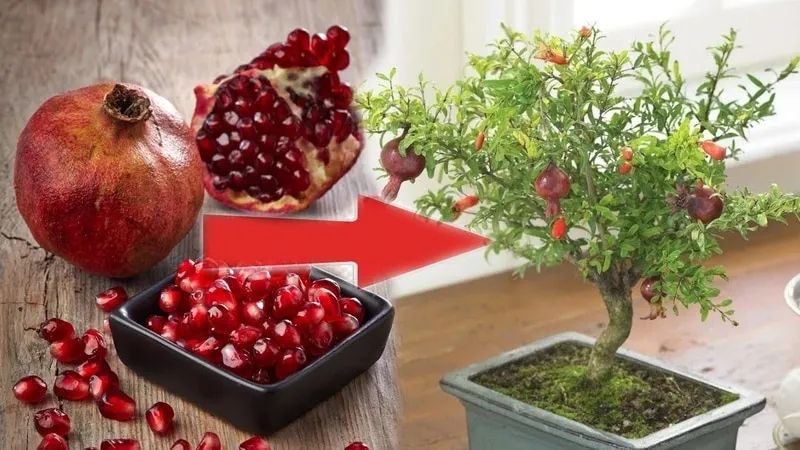Indoor pomegranate – a low-maintenance plant that, with proper care, delights with abundant flowering and fruiting. To ensure the tree thrives, it’s essential not only to choose the right soil and location in your home but also to fertilise it regularly. This article explains how and what to feed your pomegranate when growing it indoors.
Table of contents
What an indoor pomegranate needs
For planting, you can buy ready-made seeds adapted for indoor conditions or take them from a store-bought fruit. The rarest method of propagating this plant indoors is cuttings (growing from branches of a fruit tree).

To grow a fruiting pomegranate tree, follow these care guidelines:
- Light. This is a very light-loving plant, so place it near south-facing windows. Protect young shoots from direct sunlight.
- Temperature. For prolonged and abundant flowering, maintain a constant temperature of +20…+25°C from May to September. During fruiting, +12…+16°C is sufficient. In winter, to allow the plant to rest, move it to a cool place with temperatures no higher than +10…+12°C.
- Watering. Water generously while the plant is establishing itself. Reduce frequency during flowering, but ensure the soil doesn’t dry out. During winter dormancy, the pomegranate barely needs water – water once a week.
- Fertilisation. Fertilise only during flowering and fruiting. Avoid feeding in winter.
- Humidity. In summer, the pomegranate benefits from extra humidity, so mist it on particularly hot days.
- Pest and disease control. Inspect the tree regularly to prevent unexpected issues. Treat with appropriate products at the first sign of insects or disease.
- Repotting. This indoor plant can grow up to 2 m tall, so repot it into larger containers regularly. Young pomegranates – once a year; mature trees – at least once every 3 years.
- Pruning. Annually, in February, remove old branches.
To shape the pomegranate’s crown correctly, pinch back young growth regularly.
How often and when to fertilise
For healthy growth, pomegranates need regular nitrogen, organic, and potassium-phosphorus fertilisers. The first application should be during planting. Always follow recommended dosages, especially during flowering, to avoid harming the plant.
Focus on fertilisation during spring and summer. Apply feed at least twice a month after watering. Ideally, "feed" the pomegranate weekly, alternating different supplements.
In winter, during dormancy, the tree does not need fertilisers.
Best fertilisers for pomegranates

Fertilisation is done in two ways – root and foliar. Different types of fertilisers are used: organic, mineral, and home remedies.
Organic fertilisers
Organic fertilisers should only be applied to the soil after watering. Their key advantage is nutritional value and eco-friendliness.
One of the most popular organic fertilisers is manure tea, diluted with water in a 1:10 ratio before application.
Another common option is chicken manure solution, prepared as follows:
- Mix one part manure with two parts water.
- Cover and leave in a warm place for 2-3 weeks.
- Dilute the infusion with water in a 1:25 ratio.
- Before applying, dilute further (3:4 with water) to avoid root damage.
Mineral fertilisers
Mineral fertilisers are useful if organic ones prove ineffective or the soil is severely depleted. These are not applied to the soil but used for foliar spraying.
Mineral fertilisers are categorised by composition:
- Potassium salts;
- Superphosphates;
- Phosphates;
- Nitrogen-based fertilisers.
During flowering, use phosphorus-based fertilisers; in spring, during active growth, opt for nitrogen-rich feeds. In autumn, the plant benefits from potassium and organic fertilisers.
Note. Spray mineral fertilisers only on cloudy days or in the evening to avoid leaf burn.
Home remedies
Homemade solutions are a great alternative to mineral fertilisers.
Banana peels
A banana peel infusion or powder prevents potassium, magnesium, and phosphorus deficiency.
To prepare, soak one banana peel in 250 ml of water, then strain. Water the plant once a week.
For powder, dry the peels, grind them, and sprinkle the powder at the base.
Potato peels
An excellent substitute for manure or chicken manure. Boil the peels, cool, strain, and use the water for watering.
Citrus peels
Use peels from lemons, oranges, or other citrus fruits.
Preparation:
- Mix equal parts citrus and pomegranate peels.
- Pour hot water over them.
- Steep for at least 3 days in a dark place.
- Strain and use weekly.
This infusion is best used after winter dormancy, during active growth.
Seasonal fertilisation and growth phases

With proper care, indoor pomegranates reward you with lush blooms and fruit.
In mid-spring, after the cold season, pomegranates need nitrogen-rich fertilisers to support leaf and shoot growth.
In summer, phosphorus-based fertilisers encourage bud development and flowering.
In autumn, as fruits form, potassium-based fertilisers boost yield and strengthen the plant for winter.
Fertilisers for larger fruit

Without proper care or fertilisation, fruiting may not occur.
For fruit production, prioritise organic fertilisers. Avoid overfeeding, as excess nitrogen inhibits flowering and fruiting. Once or twice a month is sufficient.
Fertilisation guidelines
To prevent soil depletion, fertilise the day after watering. When applying organic fertilisers, protect the trunk to avoid damage.
Feeding schedule:
- February – May: Ammonium nitrate or urea;
- May – September: Phosphorus-based fertilisers;
- October – November: Potassium or organic fertilisers.
Healthy young plants need feeding every 2 weeks; weaker trees – weekly.
Conclusion
Pomegranates are among the hardiest decorative fruit trees. For a successful harvest, maintain optimal temperatures, water timely, fertilise appropriately, and repot as needed. Following these guidelines, you can expect fruit within 3-4 years.







